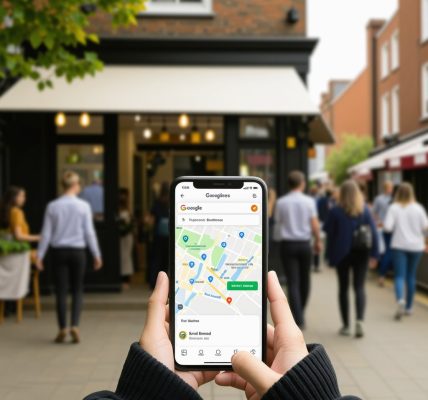Unlocking the Treasure Chest: Why Google Keyword Planner Is Your GMB’s Best Friend
Picture this: you’ve set up your Google My Business (GMB) profile, but your local customers seem to be playing hide-and-seek. What if I told you the secret to making your business shine brightly in local search results lies within a free tool you might be overlooking—Google Keyword Planner? It’s not just for AdWords anymore; it’s a goldmine for boosting your GMB content with laser-focused keywords that attract the right eyeballs.
From Guesswork to Data-Driven Brilliance: Your GMB Content Gets a Makeover
Think about the last time you tried writing a business description or a post without knowing what your customers are actually searching for. It’s like throwing darts blindfolded. Google Keyword Planner swoops in, revealing search volumes, competition levels, and keyword suggestions tailored to your niche and location. Suddenly, you’re not just guessing—you’re strategizing with precision.
Could Keyword Research Be the Missing Link in Your Local SEO Strategy?
Absolutely! By weaving carefully chosen keywords from Google Keyword Planner into your GMB business description, posts, and FAQs, you signal to Google that your profile is the local authority. For instance, if “best vegan cafe in Brooklyn” is trending in your area, sprinkling that phrase naturally into your content can skyrocket your visibility. This tactic doesn’t just increase your chances of popping up in local searches; it also attracts customers who are ready to engage.
Pro Tips: Making the Most Out of Google Keyword Planner for GMB
- Start Broad, Then Get Specific: Begin with general keywords related to your business, then refine to long-tail keywords that reflect how locals actually search.
- Spy on Competitors: Use the planner to peek at keywords your competitors rank for and find gaps you can exploit.
- Localize Your Keywords: Incorporate neighborhood names, landmarks, or other local identifiers to boost relevance.
- Refresh and Repeat: Keyword trends evolve, so revisit the planner regularly to keep your GMB content fresh and optimized.
I’ve seen businesses transform their local visibility simply by harnessing this tool’s power—turning obscure profiles into local legends. For a deeper dive into refining your GMB presence, check out this expert guide on using Google Keyword Planner for GMB.
Ready to Turn Keywords into Customers? Let’s Talk!
If you’ve tried keyword planning but still feel like your GMB isn’t scoring high enough in local searches, share your experience below. Or better yet, explore how professional SEO audits can amplify your efforts at Ranking SEO GMB Audit. Remember, in the local SEO game, knowledge isn’t just power—it’s profit.
According to Moz’s definitive guide to keyword research, understanding what your audience searches for is foundational to SEO success. So why not let Google Keyword Planner be your compass in the wild world of local search?
Beyond Basics: Leveraging Semantic Keywords to Elevate Your GMB Profile
While Google Keyword Planner excels at uncovering primary keywords, true mastery comes with integrating semantic or related keywords that enrich your GMB profile’s context. Semantic keywords help Google better understand your business’s niche, improving your chances to appear in diverse but relevant local queries. For example, a “vegan cafe” can expand with terms like “plant-based meals,” “healthy brunch spots,” or “organic coffee near me.” This layered approach signals expertise and authority to search engines, a tactic validated by SEO experts worldwide.
How Does User Intent Influence Keyword Selection for Local SEO?
User intent is the compass guiding keyword strategy for GMB optimization. Are users looking for information, ready to buy, or seeking directions? Keywords reflecting transactional intent (e.g., “order vegan brunch Brooklyn”) often convert better than purely informational terms. Aligning your GMB content with these intents enhances user engagement and local ranking. To dissect user intent effectively, tools like Google Trends and even direct customer feedback become invaluable in crafting keywords that resonate and convert.
Can Integrating Google Keyword Planner with Other Local SEO Tools Amplify Results?
Absolutely. Combining Google Keyword Planner insights with specialized local SEO tools like BrightLocal or Whitespark can unlock a nuanced understanding of citation consistency, competitor backlinks, and review sentiment. This integrated approach enables businesses to identify not only which keywords to target but also how to structure their entire local SEO ecosystem for maximum impact. For instance, using BrightLocal for GMB optimization synergizes perfectly with keyword data to boost rankings and visibility in Google Maps.
Adding this multi-tool strategy to your SEO arsenal empowers you to outmaneuver competitors who rely solely on basic keyword research, turning your GMB profile into a powerhouse of local authority.
Practical Advice: Refreshing Your Keyword Strategy for 2025 and Beyond
- Monitor Seasonal Trends: Tailor keywords to reflect seasonal demand spikes and local events, keeping your GMB content timely and relevant.
- Focus on Voice Search Optimization: With more users employing voice commands, include conversational long-tail keywords and natural language phrases.
- Use Negative Keywords Strategically: Filter out irrelevant searches by identifying and excluding keywords that drain your budget or misdirect traffic.
- Regularly Update Your GMB Posts: Leverage fresh keyword-rich posts to maintain engagement and signal activity to Google’s algorithm.
Staying proactive with keyword strategy is not just good practice; it’s essential for sustainable local SEO success. For a comprehensive strategy that includes these advanced tactics, consider exploring our local SEO optimization techniques page.
What Are the Hidden Pitfalls in Solely Relying on Keyword Planner for GMB SEO?
While Google Keyword Planner provides invaluable data, relying exclusively on it may overlook nuanced user behavior patterns and emerging local trends. For example, it may not fully capture hyperlocal slang or emerging colloquialisms that locals use when searching, which can be critical for ultimate visibility. Diversifying your keyword research sources and continuously testing your GMB content performance will mitigate such risks and enhance your local SEO resilience.
According to Search Engine Journal, integrating multiple data sources and continuous testing is crucial for advanced local SEO success (Search Engine Journal’s Local SEO Guide).
Join the Conversation: How Are You Enhancing Your GMB Keyword Strategy?
Your experience matters! Share your successes or challenges in optimizing GMB keywords. Have you combined tools like Google Keyword Planner with local SEO platforms? Comment below or contact us to discover tailored strategies that can elevate your local search performance.
Semantic Search and Latent Intent: Elevating Your GMB with Contextual Keyword Architecture
As Google’s algorithms evolve, they increasingly prioritize understanding the semantic context behind queries rather than just matching exact keywords. This means that your Google My Business (GMB) profile benefits immensely from a keyword strategy that moves beyond surface-level phrases to incorporate latent semantic indexing (LSI) keywords and related concepts. For example, a local “vegan cafe” that integrates terms like “plant-based nutrition,” “ethical dining experience,” and “eco-friendly practices” not only broadens its topical relevance but also signals expertise and trustworthiness to search engines.
Developing a rich semantic keyword map requires analyzing not just what your customers type but also what they implicitly mean. Tools such as Google’s Natural Language API or third-party semantic keyword platforms can help identify these nuanced relationships. Integrating this layered keyword approach into your GMB description, FAQs, and posts ensures your profile appears in a wider array of relevant local searches, capturing demand you might otherwise miss.
Harnessing Behavioral Analytics to Refine Keyword Targeting for GMB
Beyond keyword volume and competition metrics, understanding user behavior signals—like click-through rates (CTR), bounce rates, and conversion paths—can profoundly inform your keyword strategy. For instance, if certain keywords drive high traffic but low engagement on your GMB posts, it might indicate misaligned user intent or content gaps.
Integrating Google Analytics with GMB insights allows you to track how visitors interact with your profile after discovering it via specific keywords. This data-driven feedback loop enables continuous refinement of your keyword targeting, ensuring that the terms you optimize for lead not only to visibility but also to meaningful customer action.
How Can N-Gram and Phrase Analysis Improve Keyword Discovery for Local SEO?
N-gram analysis—examining consecutive word groupings within search queries—can unearth common phrase patterns and emerging local search behaviors that single keywords might miss. For example, analyzing 2- or 3-word combinations like “late-night vegan cafe” or “gluten-free brunch Brooklyn” reveals highly targeted search intents. By incorporating these granular phrases into your GMB content, you can capture niche audiences with specific needs, boosting relevance and conversion potential.
Advanced SEO tools such as SEMrush and Ahrefs offer functionality to perform n-gram and phrase analysis, providing actionable insights beyond what Google Keyword Planner alone can deliver.
Strategic Integration: Synchronizing Google Keyword Planner with Local Schema Markup
To push your GMB optimization to expert levels, combining keyword insights with structured data techniques like LocalBusiness schema markup can be transformative. Schema markup embeds machine-readable tags into your website and GMB-linked content, helping search engines understand key business attributes such as services, location, hours, and reviews.
By aligning your keyword research with schema properties—ensuring keywords appear naturally in titles, descriptions, and service lists marked up with schema—you create a semantic web of signals. This synergy improves the chances of rich results, such as knowledge panels and local packs, leading to enhanced visibility and click-throughs.
For comprehensive guidelines on implementing LocalBusiness schema, Google’s official documentation (Google Developers: LocalBusiness structured data) offers authoritative step-by-step instructions.
Integrating these advanced keyword strategies with your GMB profile can unlock unprecedented local search prominence. Ready to dive deeper into semantic keyword mapping or schema integration? Reach out to expert consultants or explore specialized SEO platforms to tailor these tactics to your unique business context.
Decoding the Power of Latent Intent in Google My Business Keyword Strategy
In the intricate dance of local SEO, understanding latent intent transforms keyword strategy from mere guesswork into a finely tuned symphony. Latent intent refers to the subtle, often unspoken motivations behind a search query—beyond the keywords themselves. For your Google My Business (GMB) profile, tapping into this hidden layer means crafting content that aligns not only with obvious search terms but also with the deeper needs and context of your potential customers.
For example, a search for “affordable vegan brunch Brooklyn” might implicitly signal a user prioritizing budget-conscious yet quality dining experiences. By integrating nuanced phrases reflecting affordability, ambiance, and dietary options, your GMB content can resonate more authentically and rank higher for these multifaceted queries.
How Can Behavioral Analytics Refine Keyword Targeting to Maximize Local Conversions?
Beyond identifying high-volume keywords, behavioral analytics offers a granular lens to assess how users interact with your GMB profile after discovery. Metrics such as click-through rates (CTR), user engagement time, and conversion pathways reveal which keywords truly drive meaningful actions versus those that merely attract clicks.
Integrating tools like Google Analytics with GMB insights enables continuous adjustment of your keyword strategy, ensuring alignment with actual user behavior. For instance, if “organic coffee near me” attracts visitors but results in low engagement, re-evaluating related semantic keywords or enhancing your content’s call-to-action can bridge this gap.
Such data-driven refinement fosters a feedback loop that elevates your profile’s local relevance and profitability. For an in-depth exploration of these advanced techniques, visit our GMB SEO Audit page.
Unlocking N-Gram and Phrase Analysis: The Secret Sauce for Local SEO Precision
Single keywords only scratch the surface. N-gram and phrase analysis delve into the intricate combinations of words that reflect authentic local search behavior. By examining common bigrams and trigrams—such as “late-night vegan cafe” or “gluten-free brunch Brooklyn”—you can tailor your GMB content to capture highly specific search intents that competitors often overlook.
Employing advanced SEO platforms like SEMrush or Ahrefs helps uncover these valuable phrase patterns, enabling you to craft compelling business descriptions and posts that resonate with niche audiences and boost conversion potential.
Why Is Schema Markup Integration a Game-Changer for Your GMB Keyword Strategy?
Schema markup, specifically the LocalBusiness schema, enriches your website and GMB-linked content with structured data that search engines can easily interpret. By synchronizing your keyword insights with schema properties—embedding keywords naturally into titles, service descriptions, and FAQs marked up with schema—you amplify your profile’s semantic clarity.
This strategic integration often results in enhanced search features like knowledge panels, rich snippets, and local packs, which significantly increase your visibility and click-through rates. For authoritative guidance, consult Google Developers: LocalBusiness structured data.
Are You Ready to Elevate Your Local SEO Game with Expert Multilayered Strategies?
Local SEO mastery demands more than basic keyword stuffing—it requires a sophisticated fusion of semantic keyword mapping, behavioral analytics, phrase-level insights, and structured data implementation. Share your experiences or challenges in optimizing your GMB profile’s keyword strategy below, or contact us for tailored guidance designed to unlock your business’s full local potential.
Expert Insights & Advanced Considerations
Semantic Richness Outperforms Keyword Density
While traditional keyword stuffing is obsolete, integrating semantic keywords that reflect user intent and contextual relevance provides a robust signal to Google. This layered approach enhances your Google My Business profile’s authority by capturing nuanced local searches beyond exact-match terms. By embracing semantic architecture, you elevate your GMB presence to resonate authentically with both users and search engines.
Behavioral Analytics as a Feedback Loop
Leveraging user engagement metrics such as click-through rates and conversion patterns offers an empirical basis for refining your keyword targeting. Integrating Google Analytics data with GMB insights transforms your strategy from static to dynamic, allowing continuous optimization that aligns your keyword portfolio with actual customer behavior and preferences.
Phrase-Level N-Gram Analysis Reveals Untapped Local Niches
Delving into common bigrams and trigrams uncovers highly specific search patterns that single keywords miss. These granular phrases capture precise user needs, enabling your GMB content to attract niche audiences with high conversion potential. Employing tools like SEMrush or Ahrefs to perform this analysis empowers you to stay ahead in competitive local markets.
Schema Markup Integration Amplifies Semantic Clarity
Embedding LocalBusiness schema markup in your website and GMB-linked content creates a structured data ecosystem that search engines can parse effortlessly. When aligned meticulously with your keyword strategy, schema markup can unlock rich search features such as knowledge panels and local packs, substantially boosting visibility and click-through rates.
Multi-Tool Synergy Enhances Local SEO Outcomes
Combining Google Keyword Planner with specialized local SEO platforms like BrightLocal or Whitespark delivers a holistic view of your local search landscape. This synergy not only informs keyword selection but also guides citation consistency, backlink acquisition, and reputation management, culminating in a comprehensive, competitive local SEO strategy.
Curated Expert Resources
- Moz’s Definitive Guide to Keyword Research: Offers foundational and advanced insights critical for mastering keyword strategy in local SEO contexts (moz.com/learn/seo/keyword-research).
- Google Developers: LocalBusiness Structured Data: Provides authoritative instructions on implementing schema markup to enhance your GMB profile’s semantic signals (developers.google.com/search/docs/appearance/structured-data/local-business).
- Search Engine Journal’s Local SEO Guide: Covers comprehensive local SEO tactics, emphasizing diversified data sources and continuous testing for sustained success (searchenginejournal.com/local-seo-guide).
- SEMrush and Ahrefs: Advanced SEO platforms that facilitate n-gram and phrase analysis, competitive keyword research, and ongoing performance tracking (semrush.com, ahrefs.com).
- Ranking SEO GMB Audit: Our detailed audit service that integrates behavioral analytics and keyword insights to elevate your GMB local search performance (rankingseogmb.com/gmb-seo-audit-improve-your-local-search-performance).
Final Expert Perspective
Mastering Google Keyword Planner for your GMB profile transcends basic keyword insertion; it demands a sophisticated, multilayered approach blending semantic keyword mapping, behavioral analytics, phrase-level insights, and structured data integration. This comprehensive strategy not only aligns your content with evolving search algorithms but also authentically connects with the latent intent of your local audience. Elevate your local SEO by embracing these expert tactics and consider leveraging professional audits for customized optimization. For a deeper dive into these advanced strategies, explore our GMB SEO Audit and local SEO optimization techniques. Share your experiences or reach out via our contact page to engage with experts ready to amplify your Google My Business success.





I found this post incredibly helpful, especially the emphasis on integrating semantic keywords and understanding latent user intent. In my experience managing local SEO for a chain of cafes, I’ve seen how nuanced keyword strategies can significantly boost visibility. One thing I’ve noticed is that, beyond keyword research, keeping an eye on customer reviews and feedback provides powerful insights into what local audiences really care about. For instance, what phrases do they naturally use when describing their experience? Has anyone tried combining Google Keyword Planner data with customer feedback to refine their GMB content? I’d be curious to hear how others are balancing these different data sources to craft authentic, engaging profiles that resonate with the community.
This post hits on a crucial point: using Google Keyword Planner isn’t just about finding popular keywords, but about unearthing those hidden gems that truly connect with your local audience. In my experience managing local SEO for a boutique fitness studio, I’ve seen firsthand how localizing keywords—adding neighborhood names, landmarks, and even colloquialisms—can make a tangible difference in visibility. I especially appreciate the emphasis on integrating semantic keywords and user intent, as these aspects help craft content that resonates more authentically.
One challenge I often encounter is balancing the keyword data with genuine community voice—reviews, social chatter, and feedback. Has anyone found effective ways to combine keyword research insights with real customer language? I think the best results come when we listen closely to how our customers describe their needs and experiences. Would be great to hear how others are translating these insights into their GMB content to boost engagement and conversions.
This post really hits the mark when it comes to emphasizing the importance of strategic keyword research using tools like Google Keyword Planner for GMB optimization. In my own experience running a local bakery, I’ve found that focusing on long-tail, location-specific keywords—like “gluten-free bakery downtown Portland”—has made a noticeable difference in attracting targeted local traffic. I also try to incorporate seasonal trends and popular local events into my keyword strategy, which keeps my GMB content fresh and relevant. One challenge I face is balancing keyword optimization with authentic engagement through reviews and customer feedback. Has anyone found effective ways to seamlessly integrate keywords into responses to reviews or Q&As while maintaining an engaging tone? I believe that authenticity is just as critical as optimization to build trust and community presence. Would love to hear how others manage this balance and any tips for staying natural while optimizing for local visibility.